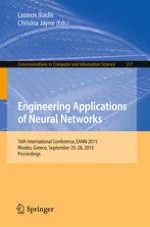This book constitutes the refereed proceedings of the 16th International Conference on Engineering Applications of Neural Networks, EANN 2015, held in Rhodes, Greece, in September 2015.
The 36 revised full papers presented together with the abstracts of three invited talks and two tutorials were carefully reviewed and selected from 84 submissions. The papers are organized in topical sections on industrial-engineering applications of ANN; bioinformatics; intelligent medical modeling; life-earth sciences intelligent modeling; learning-algorithms; intelligent telecommunications modeling; fuzzy modeling; robotics and control; smart cameras; pattern recognition-facial mapping; classification; financial intelligent modeling; echo state networks.
